Fig. 1.
a The three configurations of the Müller-Lyer illusion: expanding, contracting and control. b Basic trial structure: A fixation cross appears on the screen. After a random interval (range 200–800 ms), the fixation cross is replaced with one of the three configurations of the Müller-Lyer illusion. Depending on the predictability condition, the stimulus appeared to the right of the fixation cross (highly predictable), to the left or right of the fixation cross (moderately predictable) or in any of four possible locations: left, right, above or below the fixation cross (least predictable). In the “short stimulus duration” condition, the stimulus was visible for 80 ms, whereas in the “long stimulus duration” condition the stimulus remained visible until 300 ms after a saccade was made in the correct direction

